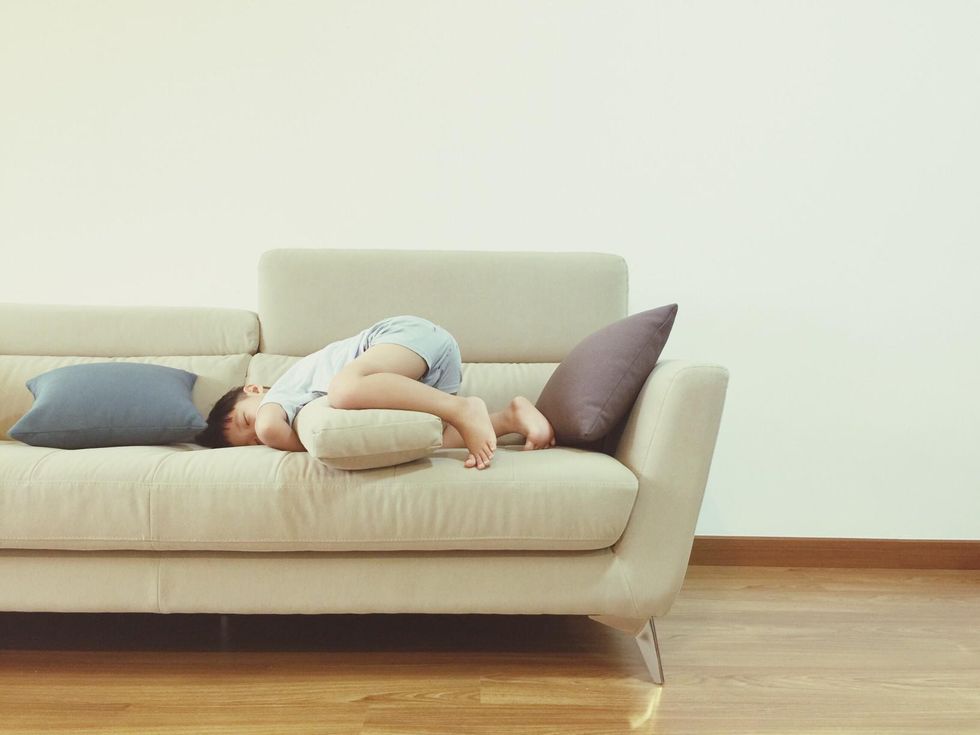What to do when your toddler needs a nap but won’t take one
Daytime naps might last just a few short hours, but they can affect all 24 hours of a child’s day. Naps can improve a child’s mood and reduce fussiness, crying, whining and tantrums. Studies show that children who nap daily also get sick less often and grow taller than their peers. Plus, naps enhance attention span and brain development—the benefits are nearly endless!
Naps can also help make up for any shortage in nighttime sleep. Even a one hour shortage in overall sleep hours can have a negative effect on a child, compromising alertness and brain function and increasing fussiness and fatigue.

There are many ideas for helping a child to take a nap, but the best idea in the world may not work for you if the solution doesn’t address the reason that your toddler won’t nap. There is not just one reason that babies and toddlers refuse to nap—there are hundreds of different reasons. Before you decide on a solution, you need to understand why your toddler is fighting naps. Once you figure out why your toddler won’t nap, you can put together a plan to overcome his resistance.
Here are some typical reasons your toddler won’t nap—and suggestions to solve each problem.
Problem: Your child has outgrown their current nap schedule.

Solution: Think about any changes in your child’s life, growth or development. Have they learned to crawl, begun to eat solid food or started daycare? Any change can also affect sleep patterns. Watch your child for signs of tiredness between naps and adjust your schedule to meet their new needs.
Problem: The nap schedule doesn’t match your child’s biological clock.

Solution: Nap time, bedtime, mealtime, exposure to light and darkness and activity can all affect your child’s biological clock. Look at your child’s schedule to be sure these things occur at reasonable times every day. The improper order of things (such as active, brightly lit playtime just before bed) can affect your child’s sleep rhythms.
Problem: Their nap schedule isn’t consistent from day to day.

Solution: If on weekdays nap times, bedtime and wakeup time are specific, but on weekends they’re hit-and-miss, then your child could be functioning with a constant case of jetlag. Other inconsistencies can also affect this, such as when your child naps at a certain time at daycare, but a different time at home, or if they take a nice long nap on days when you are at home but take a short one in the car (or skips a nap entirely) when you are on the go. Set up a possible nap schedule for your child and do your best to stay within a half hour of the nap times that you have set up.
Problem: Your child is overtired and over-wired by nap time.

Solution: If you miss your child’s signs of fatigue they can quickly move past their tired spell, past overtired, and into a second wind—that state of artificial energy which often brings with it more crying, fussing, whining and tantrums. When you miss your child’s tired signs it also means they won’t be able to fall asleep when you do finally put them in bed.
To learn your child’s sleepy signs it can help to watch them in the hour after they first wakes up in the morning, when they are well rested. Compare this to their behavior during the time from dinner to bedtime, when most children show signs of fatigue. As their usual bedtime draws near, make note of how their behavior and body language differs from when he are alert and refreshed. Aim to put your child for a nap as soon as they show signs of fatigue. A tired child will fall asleep easily and sleep longer and better.
Problem: You’ve been relying on a specific sleep aid.

Solution: A child who is accustomed to falling asleep in one very specific way can easily become so used to this one method, such that if you try to have them nap under any other condition they would be physically unable to do so. The best way to understand a child’s association needs are to examine them from your own viewpoint. It’s possible that you sleep well in your own bed but struggle to sleep at a hotel or someone else’s home. Some children’s sleep associations are so strong it can only be compared to asking you to sleep on a roller coaster!
The most common nap-preventing associations are breastfeeding or bottle-feeding to sleep, being held by loving arms or sleeping in a swing, bouncer or car seat. These are wonderfully comforting places for a child to nap, but when they become necessary for sleep then it’s likely to cause a problem for the parent who must provide nap time services.
Related: A sleep scientist shares her best sleep tips for traveling with babies and kids
These associations are usually so necessary to your child’s sleep that they override every other reason or solution. Try weaning your child off of the nap association over the course of a week. There may be tears at first, but they’ll be better able to adapt and rest in the long run.
Problem: Your child is taking sneaky micro-naps.

Solution: The very first stage of sleep can last as little as five minutes and can reduce feelings of sleepiness—it lifts the lid and lets the steam out just enough. If your child hits a tired zone and is lying on the sofa, sitting in a swing, or going for a ride in the car, they may nod off for five or ten minutes. This micro-nap doesn’t give your child the full benefit of a real nap, but can be just enough to rejuvenate them and prevent them from being able to sleep when you put him in bed later for a nap.
To circumvent this problem, avoid putting your child in a nap-inducing environment, like a ride in the car or time in their swing, at a time when he’s likely to need a nap, unless you can leave him for a full long nap.
Problem: Your child has health troubles.

Solutions: If any health issue is bothering your child it can definitely affect their sleep. Allergies and asthma are two of the most common childhood diseases. Both of these conditions can make it difficult for your child to breathe comfortably when lying down. Colic, reflux, ear infections and difficult bouts of teething are other conditions that can prevent a child from napping well.
If your child suffers from any medical issues good naps are especially important for their health. If this is the case with your child it will be helpful if you are very flexible and open to finding any solution that helps them sleep. Put aside any notion that your child must sleep in a certain place or a certain way, and open yourself to the concept that any nap is better than no nap at all.
At the same time, talk with various medical experts about your child’s health matters and look to find the best solutions for your child.
Tips for encouraging nap time
No matter why your child won’t nap, there are a few specifics that can be helpful as you encourage any child to take regular naps. Keep these basic principles in mind:
- Maintain a consistent daily schedule that works with your child’s natural body clock. Create a predictable pattern to the day—with meals and nap time happening at reliable times.
- Modify your schedule according to your child’s sleepy signs. No matter what the clock says, it’s nap time when your child becomes quieter, loses interest in toys or playtime, fusses, stares off into the distance, rubs his eyes or ears, and of course: if they begin to yawn.
- Have a relaxing pre-nap routine to cue your child that nap time is here and help them wind down and relax.
- Set up a sleeping place that is cozy and that sets the stage for sleep. Dress your child comfortably for sleep.
- Keep mornings bright and active, and the half hour before each nap session quiet, dimly lit and calm.
- Keep in mind that you cannot force a child to sleep, but you can follow the basic rules of biology, gauge your child’s sleepy signals and create a setting that is inductive to sleep and relaxation.
From The No-Cry Nap Solution: Guaranteed Gentle Ways to Solve All Your Naptime Problems by Elizabeth Pantley (McGraw-Hill, January 2009).
Raising a good sleeper isn’t always easy. Here are some ways to help.
A version of this story was published October 5, 2021. It has been updated.







